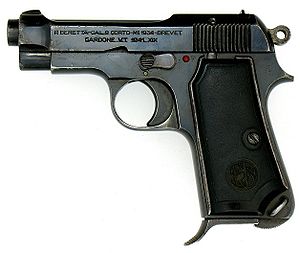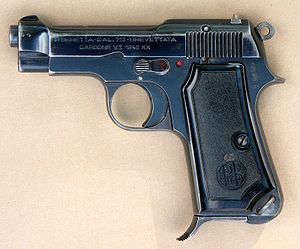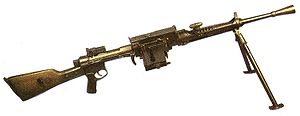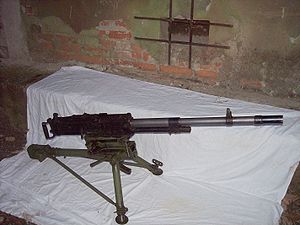
Italian Army equipment in World War II
Encyclopedia
Infantry weapons
- Bodeo Model 1889Bodeo Model 1889The Bodeo Model 1889 revolver was invented by Italian firearm designer Carlo Bodeo. It was produced by a wide variety of manufacturers between 1889 and 1925, and was also produced in Spain from 1915 to 1918...
10.35mm revolver - Glisenti Model 1910Glisenti Model 1910The Glisenti Model 1910 was a 9mm calibre semi-automatic service pistol produced by the Italian company Real Factory D'arma Glisenti. It was introduced in 1910 and adopted by the Royal Italian Army, seeing service in World War I and World War II....
9mm Glisenti9mm GlisentiThe 9mm Glisenti cartridge was developed for the Glisenti Model 1910, an Italian sidearm used in the First World War. The cartridge was based on the German 9 mm Parabellum, but it is slightly less powerful....
semi-automatic pistol - Beretta M1934Beretta M1934The Beretta model 1934 is a compact, semi-automatic pistol which was issued as a standard service firearm to the Italian armed forces beginning in 1934...
.380 ACP.380 ACPThe .380 ACP pistol cartridge is a rimless, straight-walled pistol cartridge developed by firearms designer John Browning. The cartridge headspaces on the mouth of the case. It was introduced in 1908 by Colt, and has been a popular self-defense cartridge ever since...
semi-automatic pistol |image=
- Beretta M 1935 .32 ACP.32 ACP.32 ACP , also known as the .32 Automatic is a pistol cartridge. It is a semi-rimmed, straight-walled cartridge developed by firearms designer John Browning, initially for use in the FN M1900 semi-automatic pistol...
semi-automatic pistol |image=
- Beretta Model 1918Beretta Model 1918The Beretta Model 1918 was a submachine gun that entered service in 1918 with the Italian armed forces and came with an overhead inserted magazine. Another variant was the Model 1918/30 with the magazine inserted underneath and came with a bayonet...
9mm Glisenti submachine gun - Beretta Model 38/42Beretta Model 38/42The Model 38 and its variants were the official submachine guns of the Royal Italian Army during World War II. The MAB 38A , or Modello 38A, was introduced in 1938...
9mm Parabellum submachine gun | image=
- OVP (firearm)OVP (firearm)The OVP was a light submachine gun developed in Italy.- Development :The Italians were the first army ever to adopt a submachine gun, or more correctly, a light automatic gun firing a pistol cartridge. This was the Villar Perosa that ceased to be a service weapon in 1918...
9mm Glisenti submachine gun - FNAB-43FNAB-43The FNAB-43 is an Italian designed and developed submachinegun manufactured from 1943 to 1944. The first prototype was built in 1942 and the 7,000 built by the FNA-B were issued to German and Italian RSI units fighting in Northern Italy...
9mm Parabellum submachine gun - TZ-45TZ-45The TZ-45 was an Italian made submachine gun produced in small numbers between 1944 and 1945, with an estimated 6,000 made.- History :The TZ-45 submachine guns was designed by two Italian brothers, Tonon and Zorzoli Giandoso, and was produced by their own small company. All the TZ 45's were issued...
9mm Parabellum submachine gun - CarcanoCarcanoCarcano is the frequently used name for a series of Italian bolt-action military rifles and carbines. Introduced in 1891, this rifle was chambered for the rimless 6.5x52mm Mannlicher-Carcano Cartuccia Modello 1895 cartridge. It was developed by the chief technician Salvatore Carcano at the Turin...
ordinance bolt-action rifle (in both 6.5mm and 7.35mm) | image =
- Bomba a Mano Mod. 35 impact fuse hand grenade
- Fiat-Revelli Modello 1914Fiat-Revelli Modello 1914The Fiat-Revelli Modello 1914 was an Italian water-cooled medium machine gun produced from 1914 to 1918. It was used by the Italian Army in the First World War, and was used in limited numbers into the Second World War....
6.5 mm machine gun
- Fiat-Revelli Modello 1935Fiat-Revelli Modello 1935The Fiat-Revelli 35 was a revised version of the Modello 1914, which had equipped the Italian Army of the Great War. The Modello 14 seems to have begun the Italian fascination with over-complicated loading systems and the need for lubricating rounds to prevent jamming, which often had the opposite...
8 mm Breda machine gun - Breda 30Breda 30The Fucile Mitragliatore Breda modello 30 was the standard light machine gun of the Royal Italian Army during World War II.The Breda 30 was rather unique for a light machine gun. It is magazine fed from the right side and the magazine was attached to the gun and was loaded using brass or steel 20...
6.5 mm light machine gun |image=
- Breda 37Breda M37The Breda Modello 37 was an Italian heavy machine gun adopted in 1937. It was the standard machine gun for the Royal Italian Army during World War II...
8 mm heavy machine gun |image=
- Breda 38Breda 38The Breda 38 was an Italian tank-pattern machine gun used in World War II. It was able to fit on the available tanks: the Fiat L6/40, the Fiat M11/39, and the Fiat M13/40. It was also adapted as infantry machine gun.-Development:...
8 mm tank machine gun
Mortars
Italy used a 45 mm light mortar (Brixia Model 35Brixia Model 35
- Description :The Brixia light mortar is a 45 mm calibre light mortar mounted on a legged base and designed for operation by two crew. The rear legs are fitted with a pad for the gunner to lay forward on behind the mortar, or sit upon when the situation allowed. A lever allowed for operating the...
) and an 81 mm medium mortar (Mortaio da 81/14 Modello 35
Mortaio da 81/14 Modello 35
Mortaio da 81/14 Modello 35 - Italian World War II infantry mortar, standard weapon of Italian Army during the war, of typical Brandt-system construction, but relatively lightweight, with good range and therefore considered very successful....
). Infantry battalions (1940-42 Type) included 2 platoons of 9 light mortars (18 Total), and infantry regiments included a company of 6 medium mortars.
Artillery
Italian artillery was usually designated using the calibre and length of the barrel in number of calibre lengths, so "90/53" would mean a weapon with a 90 mm diameter barrel where the length of the barrel was approximately 53 calibre lengths (i.e. 53x90 mm, that is 4.77 m).The Cannone da 47/32 M35
Cannone da 47/32 M35
The Cannone da 47/32 M35 was an Austrian artillery piece produced under license in Italy during World War II. It was used both as an infantry gun and an anti-tank gun....
was a dual-purpose anti-tank gun and infantry gun based on a design by the Austrian firm of Bohler. Because it was a dual purpose gun, its design was a compromise: anti-tank guns require a high muzzle velocity in order to maximise armour penetration, but an infantry gun required a low muzzle velocity, because that means the gun can be lighter (and therefore more easily handled), and the shell can contain more explosive (a high muzzle-velocity shell needs thicker metal to avoid disintegrating when fired).
The Cannone da 65/17 modello 13 was a lightweight infantry and mountain gun, dating from before World War I
World War I
World War I , which was predominantly called the World War or the Great War from its occurrence until 1939, and the First World War or World War I thereafter, was a major war centred in Europe that began on 28 July 1914 and lasted until 11 November 1918...
.
The Obice da 75/18 modello 34
Obice da 75/18 modello 34
The Obice da 75/18 modello 34 was an Italian artillery piece used during World War II.- History :Much of Italy is mountainous, so the Italian army has always had an interest in mountain artillery...
was a lightweight howitzer designed to be used as a mountain gun.
The Cannone da 75/32 modello 37
Cannone da 75/32 modello 37
The Cannone da 75/32 modello 37 was an Italian field gun used during World War II. .- History :...
was a field artillery piece. It was also used as an anti-tank gun.
The Obice da 100/17 modello 16 was a lighweight howitzer to be used as a mountain gun.
The Cannone da 105/28 modello 12
Canon de 105 mle 1913 Schneider
The Canon de 105 mle 1913 Schneider was a French artillery piece used in World War I and World War II by many European countries.- History :In the early 1900s, the French company Schneider et Cie began a collaboration with the Russian company Putilov...
was a field artillery piece, a French gun dating from before World War I
World War I
World War I , which was predominantly called the World War or the Great War from its occurrence until 1939, and the First World War or World War I thereafter, was a major war centred in Europe that began on 28 July 1914 and lasted until 11 November 1918...
.
The Obice da 105/14 modello 18
Obice da 105/14
The Obice da 105/14 modello 18 was a howitzer used by Italy during World War II. It appears to have been designed at the end of World War I, but that remains to be confirmed. It was originally designed to be towed by horses with wooden spoked wheels. Some weapons may have been modernized for...
was a howitzer.
The Obice da 149/12 modello 14 was a howitzer produced by Skoda
Škoda Works
Škoda Works was the largest industrial enterprise in Austro-Hungary and later in Czechoslovakia, one of its successor states. It was also one of the largest industrial conglomerates in Europe in the 20th century...
during World War I
World War I
World War I , which was predominantly called the World War or the Great War from its occurrence until 1939, and the First World War or World War I thereafter, was a major war centred in Europe that began on 28 July 1914 and lasted until 11 November 1918...
, many of which passed into the Italian army as reparations at the end of that war. The Obice da 149/13 modello 14 was a modified version of the same gun.
The Obice da 149/19 modello 37
Obice da 149/19 modello 37
The Obice da 149/19 modello 37 was a heavy howitzer which served with Italy during World War II. It was intended to replace Italy's assortment of World War I-era heavy howitzers, but this was prevented by the prolonged development time and the very slow pace of production. Despite orders totaling...
was heavy howitzer.
The Obice da 210/22 modello 35
Obice da 210/22
The Obice da 210/22 modello 35 was a Italian heavy howitzer designed by the Italian Arms and Munitions Technical Service and accepted into service by the Italian Army in 1938. A total of 346 were ordered and the gun was produced by Ansaldo at their Pozzuoli factory. However production was slow...
was a heavy howitzer.
The Mortaio da 210/8 D.S.
Mortaio da 210/8 D.S.
The Mortaio da 210/8 D.S. was a siege howitzer which served with Italy during World War I and World War II. It was an old-fashioned weapon when introduced around 1900. It was mounted on a timber firing platform and lacked a recoil system of any kind. It was mounted on a De Stefano carriage which...
was a siege howitzer.
Anti aircraft artillery
Italy used two models of 20 mm autocannonAutocannon
An autocannon or automatic cannon is a rapid-fire projectile weapon firing a shell as opposed to the bullet fired by a machine gun. Autocannons often have a larger caliber than a machine gun . Usually, autocannons are smaller than a field gun or other artillery, and are mechanically loaded for a...
:
- The Cannone-Mitragliera da 20/77 (Scotti)Cannone-Mitragliera da 20/77 (Scotti)The Cannone-Mitragliera da 20/77 was a 20 mm anti-aircraft gun produced by the Scotti company in Italy and used by that country in World War II. It used the 20x138mmB cartridge.- History :...
was designed in 1932 and produced by the Swiss Oerlikon company. - Cannone-Mitragliera da 20/65 modello 35 (Breda)
Italy also used heavier anti-aircraft guns, in calibers of 75 mm and 90 mm. The Cannone da 75/46 C.A. modello 34
Cannone da 75/46 C.A. modello 34
The Cannone da 75/46 C.A. modello 34 was an Italian anti-aircraft gun used during World War II. The designation means it had a caliber of 75 mm, the barrel was 46 caliber-lengths long and it was accepted in service in 1934.- See also :...
was designed in the 1920s based on an earlier British design. The Cannone da 90/53
Cannone da 90/53
The Cannone da 90/53 was an Italian designed cannon, and one of the most successful anti-aircraft guns to see service during World War II. It was used both in an anti-aircraft role and as an anti-tank gun...
was roughly equivalent to the famous German 88 mm gun
88 mm gun
The 88 mm gun was a German anti-aircraft and anti-tank artillery gun from World War II. It was widely used by Germany throughout the war, and was one of the most recognizable German weapons of the war...
. Like the "88", the Cannone da 90/53 was also used as an anti-tank weapon.
All calibers of AA guns were also mounted in portee trucks in dual roles (ground attack and AA).
Combat vehicles
The Italian designation system for tanks consisted of a letter (L, M or P; designating light, medium and heavy tanks respectively) followed by two numbers: one giving the approximate weight in tons, the other giving the year it was accepted for service. Thus "M11/39" means the 11 ton medium tank of 1939. The Italian definitions of light, medium and heavy tank differ from other nations at the time. For instance the Italian "medium" tanks are often described as "light" in other sources.Medium tanks
- M11/39Fiat M11/39The Fiat-Ansaldo M11/39 was an Italian Medium Tank first produced prior to World War II. The M11/39 saw service in Africa and Italy . The official Italian designation was Carro Armato M11/39...
- M13/40Fiat M13/40The Fiat-Ansaldo M13/40 was an Italian medium tank , designed to replace the Fiat L3, the Fiat L6/40 and the Fiat M11/39 in the Italian Army at the start of World War II...
- M14/41Fiat M14/41The Fiat M14/41 was a four person medium tank that served from 1941 in the Royal Italian Army. The official Italian designation was Carro Armato M 14/41...
(a M13/40 with a more powerful engine) - M15/42M15/42 tankThe Carro Armato M15/42 was an Italian medium tank of World War II. Italy begun production on 1 January 1943. By mid 1943, Italy had made 90 of them prior to the Italian Armistice on 8 September 1943...
Self-propelled guns
- Semovente 20/70 Quadruplo (one prototype only)
- Semovente 47/32Semovente 47/32The Semovente 47/32 was an Italian self-propelled gun built during World War II. It was created by mounting a Cannone da 47/32 M35 in an open-topped, box-like superstructure on a Fiat L6/40 chassis. Some were built as command tanks with a radio installed instead of the main gun...
- Semovente 75/18Semovente 75/18The Semovente 75/18 was an Italian self-propelled gun of the Second World War. It was built by mounting the 75 mm Obice da 75/18 modello 34 mountain gun on the chassis of a M13/40 or M14/41 tank. The first 60 were built using the M13/40 chassis and a subsequent 162 were built on the M14/41...
- Semovente 75/34Semovente 75/34The Semovente 75/34 was an Italian self-propelled gun in use during World War II. It was built by mounting a 75 mm L34 gun on the chassis of a M15/42 tank. 192 were built before the Italian surrender in September 1943. The vehicle was never used in combat by the Italian army...
- Semovente 90/53Semovente 90/53The Semovente 90/53 was a heavy Italian self-propelled gun and tank destroyer, used by the Italian and German Armies during World War II.-Development:...
- Semovente 105/25Semovente 105/25The Semovente 105/25 was an Italian tank destroyer in use during World War II. It was constructed by mounting a 105 mm gun that was 25 calibers long in a widened chassis from a M15/42 tank. 30 were built by Fiat-Ansaldo and delivered in 1943 before the Italian surrender in September that year...
- Semovente 149/40 (one prototype only)
External links
- Comando Supremo website; exhibits considerable detail on Italian military equipment during World War II.

